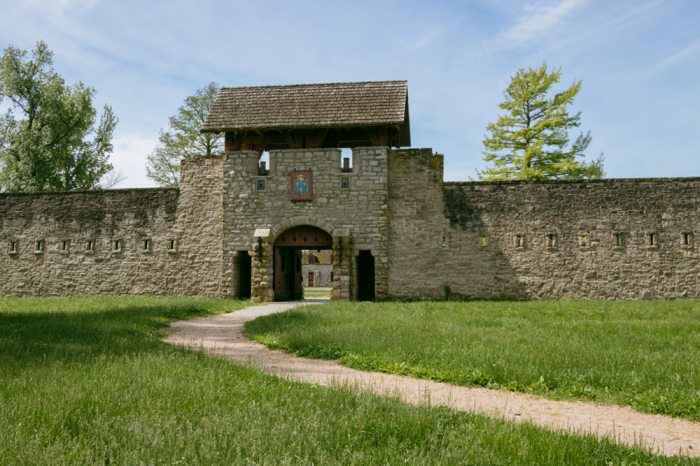America’s forgotten French history awaits you in Illinois

PRAIRIE DU ROCHER, Illinois — Getting from this rural farm town to nearby Fort de Chartres required driving atop a levee.
It was an experience straight out of Don McLean’s song “American Pie.” Except the levee wasn’t dry.
My visit to southwestern Illinois came as the waters of the Mississippi River continued to rise, surpassing the previous record from the Great Flood of 1993.
Fort de Chartres, despite being protected by a massive levee, is no stranger to floods. The present-day structure is a partial reconstruction of a French colonial fort built in the 1750s to replace an even earlier wooden fort. That wooden fort was itself the third fort constructed by the French during their rule over the Mississippi River Valley in a region once known as the Illinois Country.
What you see today is a little different than what the British found when they arrived in 1765 to occupy the fort after the Seven Years’ War, when France lost its colonial possessions in what is today Canada and the United States.
Partially rebuilt on original foundations, Fort de Chartres State Historic Site with its prominent gate and bastions is no longer oriented toward the river, where most visitors would have arrived. Today, the levee stands just beyond where the original main entrance was located. Inside the fort some of the buildings have been rebuilt in keeping with how it would have looked. Only the power magazine, which is said to be the oldest building in all of Illinois, is original. The foundations of other buildings, as well as remnants of fort’s walls, are marked out, which should make it easy if the Illinois state government ever comes up with the funds for a much-needed full reconstruction.
Despite the fort’s citadel-like appearance the Seven Years’ War — better known in North America as the French & Indian War — was never directly fought in the Illinois Country, though French marines garrisoned here did travel more than 800 miles for an engagement at Fort Niagara, north of Buffalo, New York. Another interesting footnote involves the brother of the fort’s commandant, who was killed after George Washington ambushed a party of French soldiers and their Indian allies in 1754.
Prairie du Rocher (population 604, as of the last census) has survived, but seasonal flooding long ago engulfed other villages founded by the French. In fact, a flood in 1881 was so great that the Mighty Mississippi changed its course and washed away Kaskaskia, the first capital of Illinois under the American flag. What survived became an exclave only reachable by land from Missouri.
The French colonial chapter of U.S. history is basically forgotten outside this part of the country, where reminders are everywhere. Just look at a local map. Many of the streets and place names are either their original French name or an Anglicized version.
Prairie du Rocher literally translates into English as Prairie of the Rock, as in the magnificent limestone cliff that towers above town and has since time immemorial corralled the Mississippi River. In the case of Fort de Chartres, my ears heard Chartres pronounced as “shart,” although Jennifer Duensing of the Friends of Fort de Chartres told me some old-timers call it “Fort Charters.” (The 18th century pronunciation was almost certainly the same as Chartres Street in New Orleans, another French colonial settlement.)
The rich French heritage is even more evident at several local Roman Catholic churches, all of which were established before the United States.
St. Joseph’s Church, the parish in Prairie du Rocher, where priests with French surnames served until well into the 19th century, has communion vessels from an even earlier church.
Flooding kept me from visiting Immaculate Conception, a chapel-of-ease in Kaskaskia since area parishes were consolidated in the 1990s. However, the treasures here include a bronze bell gifted by King Louis XV in 1741 and an even earlier altar carved from walnut and cottonwood. The bell has been dubbed the Liberty Bell of the West because it was rung in 1778 after Virginian frontiersman George Rogers Clark liberated the Illinois Country from British rule during the American Revolution.
Directly across from St. Louis in Cahokia is the Church of the Holy Family. The log cabin-style church, built in 1799 using traditional French colonial construction methods, was erected as a replacement for an even earlier edifice. As with Immaculate Conception, the bell came from Louis XV. It also has altar candlesticks from King Louis XIV.
If you go
I flew into St. Louis, the closest major airport. Crossing the Mississippi River into Illinois, I followed the Kaskaskia–Cahokia Trail through farmlands and small towns on what is regularly ranked as one of the best drives in all of America.
The grounds of Fort de Chartres State Historic Site are open year-round, but buildings are only open Thursday through Sunday from 9 a.m. to 5 p.m. Admission is free. Reenactments and other special events are held throughout the year, including the annual Fort de Chartres Rendezvous. This year’s event takes place June 1 and 2.
French is no longer the lingua franca, but an Old World tradition that dates locally to the 1720s is still maintained every New Year’s Eve in Prairie du Rocher. Known as La Guiannee, locals go door-to-door singing songs and partaking in drink.
Other relics of France’s influence in the Illinois Country include the ruins of the unfinished Fort Kaskaskia, the Pierre Menard Home and the old house-turned-courthouse in Cahokia.
I recommend staying at the Corner George Inn Bed & Breakfast in Maeystown, a charming village founded by German immigrants. If you want a nationally branded hotel you will have to drive about an hour to Fairview Heights.
Spires and Crosses, a travel column exclusive to The Christian Post, is published every week. Follow @dennislennox on Twitter and Instagram.





























